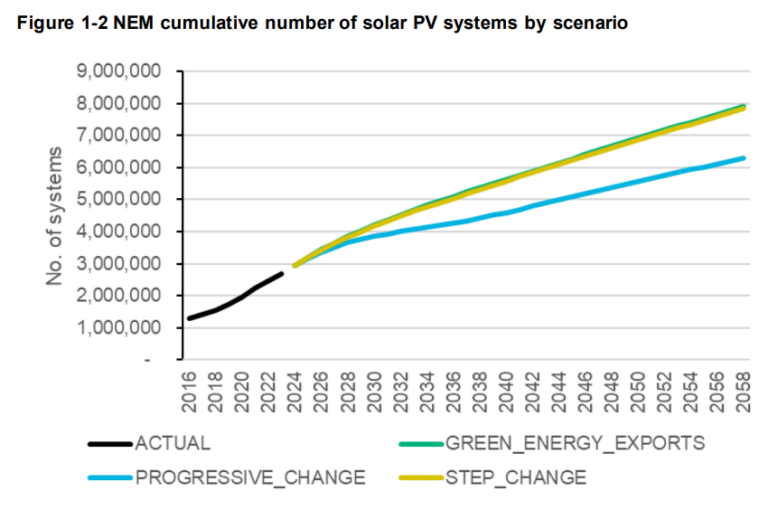GEM’s December 2023 report shows that rooftop PV installation forecasts surpass current 41 GW levels of installed capacity in Australia's National Electricity Market (NEM) for coal, gas and hydro combined, but varies depending on the government’s three decarbonization scenarios.
The scenarios are “Progressive Change,” “Step Change,” and “Green Energy Exports.” Progressive Change would see 43% emissions reduction by 2030 and net zero by 2050. The Step Change scenario is based on consumer-driven investment to maintain temperature below 2 C. Green Energy Exports foresees a limiting of temperature increase to 1.5 C, requiring rapid electrification, green hydrogen production, and bio-methane solutions.
The “Projections for distributed resources – solar PV and stationary energy battery systems” report, found under the Progressive Change model, points to a capacity by 2053/54 of 66 GW, which is higher than the Commonwealth Scientific and Industrial Research Organisation’s (CSIRO) projection used by AEMO for the same period of 48 GW.
Forecasts for the globally favored models, Step Change and Green Energy Exports, landed on a 98 GW capacity from Green Energy Markets projections, and 92 GW from CSIRO.
“No matter which way we cut this, these forecasts indicate we are headed for an amount of rooftop solar capacity (taking into account panel degradation) that is close to, or greater than typical average electricity demand,” Tristan Edis, director of analysis and advisory at Green Energy Markets and the co-author of the report. “Then on top of this we also have solar capacity in solar farms and large commercial installation above 100 kW per system. For many, such a large amount of rooftop solar capacity seems to stretch the boundaries of credibility.”
Popular content
Edis says there are four reasons to install more rooftop solar capacity than typical total electricity demand across residential customers, but every sector of the economy as well.
“Over time, given that solar panels can last 20 years, we end up with a steady accumulation of more and more capacity, even though overall the number of new sites installing solar each year is expected to decline substantially from what we’ve experience in the last few years,” Edis said.
As capacity grows and curtailment ensues, and the value of solar generation in the wholesale electricity market, along with feed-in tariffs declines, Edis said the caveat is heavily contingent on the price of home battery storage systems also declining.
To continue reading, please visit our pv magazine Australia website.
This content is protected by copyright and may not be reused. If you want to cooperate with us and would like to reuse some of our content, please contact: editors@pv-magazine.com.


By submitting this form you agree to pv magazine using your data for the purposes of publishing your comment.
Your personal data will only be disclosed or otherwise transmitted to third parties for the purposes of spam filtering or if this is necessary for technical maintenance of the website. Any other transfer to third parties will not take place unless this is justified on the basis of applicable data protection regulations or if pv magazine is legally obliged to do so.
You may revoke this consent at any time with effect for the future, in which case your personal data will be deleted immediately. Otherwise, your data will be deleted if pv magazine has processed your request or the purpose of data storage is fulfilled.
Further information on data privacy can be found in our Data Protection Policy.